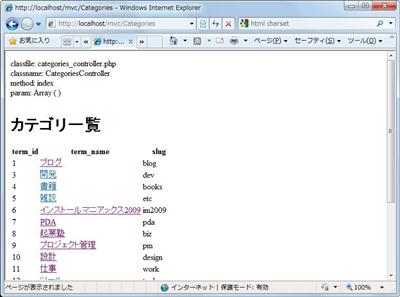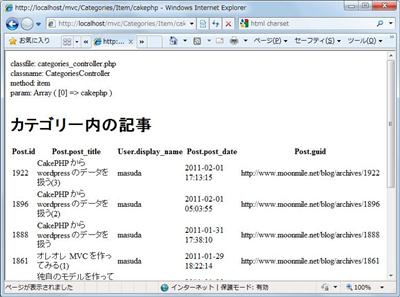オレオレ MVC を作ってみる(1) | Moonmile Solutions Blog
http://www.moonmile.net/blog/archives/1861
前回のコードを少し変更して wordpress のカテゴリ一覧とカテゴリ内の記事を表示させます。
■最初の index.php
まずは、クラス名とメソッドを取り出す index.php から。
1 2 3 4 5 6 7 8 9 10 11 12 13 14 15 16 17 18 19 20 21 22 23 24 25 26 27 28 29 30 31 32 33 34 35 36 37 38 39 | <html><head><meta http-equiv="Content-Type" content="text/html; charset=UTF-8"/> </head><body><?php$url = $_GET['url'];$url = strtolower($url);$vars = preg_split('|/|',$url);$params = array();if ( count($vars) == 1 ) { $base = $url; $method = "index";} else if ( count($vars) == 2 ) { $base = $vars[0]; $method = $vars[1];} else { $base = $vars[0]; $method = $vars[1]; for($i=2; $i<count($vars); $i++ ) { $params[] = $vars[$i]; }}$classfile = $base."_controller.php";$classname = strtoupper(substr($base,0,1)).substr($base,1).'Controller';echo "classfile: $classfile<br/>";echo "classname: $classname<br/>";echo "method: $method<br/>";echo "param: ";print_r($params); echo "<br/>";include('controllers/'.$classfile);$c = new ReflectionClass($classname);$obj = $c->newInstance();$method = $c->getMethod($method);$method->invokeArgs($obj,$params);?></body> |
GET で送られる URL から「/」でパースするところは同じで、メソッドのパラメータを受けれるようにします。これの難点は常に body タグ内に view のコードが入ってしまうことですよね。一旦他のレンダリングに任せて、その中で view のコードを呼ぶようにしないと、head タグなどが書き出せません。
■ビューを作る
1 2 3 4 5 6 7 8 9 10 11 12 13 14 15 16 17 18 19 20 | <!-- views/categories/item.php --><h1>カテゴリ一内の記事</h1><table> <tr> <th>Post.id</th> <th>Post.post_title</th> <th>User.display_name</th> <th>Post.post_date</th> <th>Post.guid</th> </tr> <?php foreach($Categories as $item) : ?> <tr> <td><?php echo $item['Post']['id']; ?></td> <td><?php echo $item['Post']['post_title']; ?></td> <td><?php echo $item['User']['display_name']; ?></td> <td><?php echo $item['Post']['post_date']; ?></td> <td><?php echo $item['Post']['guid']; ?></td> </tr> <?php endforeach; ?></table> |
ビューの作りは CakePHP の *.ctp と同じ。このあたりは互換が保てて楽ちん。
■コントローラーを作る
1 2 3 4 5 6 7 8 9 10 11 12 13 14 15 16 17 18 19 20 21 22 23 24 | <?phpinclude 'models/category.php';class CategoriesController { var $name = 'CategoriesController'; function index() { // view に渡す変数 global $Categories; // モデルを作成して $category = new Category(); // 検索 $Categories = $category->find('all'); include('views/categories/index.php'); } function item($slug) { // view に渡す変数 global $Categories; // モデルを作成して $category = new Category(); // 検索 $Categories = $category->findBySlug($slug,10); include('views/categories/item.php'); }}?> |
コントローラーは、モデルを new してからメソッドを呼ぶだけ。最後に view をインクルードして表示ってな具合です。この include 部分を変えて index.php との連携を取らないといけませんね。
■モデルの基底クラスを作る
モデルの基底クラスを作りました。
1 2 3 4 5 6 7 8 9 10 11 12 13 14 15 16 17 18 19 20 21 22 23 24 25 26 27 28 29 30 31 32 33 | <?phpclass Model { var $cn ; function open() {// $this->cn = new PDO("mysql:host=127.0.0.1;dbname=moonmile_cake",// "moonmile_cake","cakephp"); $this->cn = new PDO("mysql:host=127.0.0.1;dbname=wordpress", "wordpress","wordpress"); } function close() { $this->cn = null; } function query($sql) { $this->open(); $results = $this->cn->query($sql); $this->close(); return $this->toArray($results); } function toArray($stmt) { $items = array(); foreach($stmt as $item) { foreach($item as $key => $value) { if (strpos($key,'.') == true ) { list($table,$column) = split('\.',$key); $tables[$table][$column] = $value; } } $items[] = $tables; } return $items ; }}?> |
ひとまず、データベースの open と close は、ここから継承することにすると。後、クエリを実行した後で配列に直すのが前回はださかったので、toArray メソッドを作って自動化します。こうすることで、Term.term_id のような名前をクエリで付けておけば $item[‘Term’][‘term_id’]のように参照ができます。
■モデルを作る
この基底クラスを継承して Category モデルクラスを作ります。
1 2 3 4 5 6 7 8 9 10 11 12 13 14 15 16 17 18 19 20 21 22 23 24 25 26 27 28 29 30 31 32 33 34 35 36 37 38 39 40 41 42 43 44 45 46 47 48 49 50 51 52 53 54 | <?phprequire('lib/model.php');class Category extends Model { var $name = 'Category'; function find($type) { $sql = <<< HEREselect Term.term_id `Category.term_id`, Term.name `Category.name`, Term.slug `Category.slug`from wp_terms as Term inner join wp_term_taxonomy as TermTaxonomy on ( Term.term_id = TermTaxonomy.term_id )WHERE TermTaxonomy.taxonomy = 'category' order by Term.term_id;HERE; $items = $this->query($sql); return $items ; } function findBySlug($slug,$max) { $sql = <<< HEREselect Post.ID `Post.id`, Post.post_title `Post.post_title`, User.display_name `User.display_name`, Post.post_date `Post.post_date`, Post.guid `Post.guid`from wp_terms as Term inner join wp_term_taxonomy as TermTaxonomy on ( Term.term_id = TermTaxonomy.term_id ) inner join wp_term_relationships as TermRelationship on ( TermTaxonomy.term_taxonomy_id = TermRelationship.term_taxonomy_id ) inner join wp_posts as Post on ( TermRelationship.object_id = Post.ID ) inner join wp_users as User on ( Post.post_author = User.ID )WHERE TermTaxonomy.taxonomy = 'category'AND Post.post_status = 'publish'AND Term.slug = '$slug' order by Post.post_date desc limit $max ;HERE; $items = $this->query($sql); return $items ; }}?> |
完全にクエリを書くということで、非自動化 O/R マッピングッ!!! SQL を分かっている場合はこれでも十分かなぁと。下手に Model::$belongsTo 等で悩むよりは、と考えてしまいます。
余談ですが、CakePHP のアソシエーションは、LINQ to Entities のアソシエーションのようにグラフィカルかつダイアログ等で入力してから、コードに直してやれば良いかと思っています。LINQ to Entities の設定って XML ファイルに書き出されるので、同様に CakePHP のアソシエーションを XML に設定しておいて読み込ませるってこともできますね。
このオレオレ MVC の O/R マッピングは完全に SQL 文を書くしかない体制なので、この部分をコピー&ペーストして MySQL Workbench で実行してチェックってことになります。なので、inner join を使ってきっちり結合させます。
■実行してみる
これだけのコードで MVC が実現できます(非常にチープですが)。
まぁ、これだとリストの表示しかできないので、お次は insert, update, delete ですね。いや、その前にレイアウト読み込みをさせないと。




